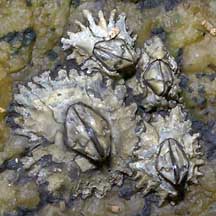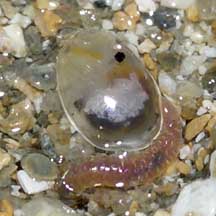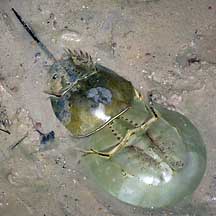 |
|
|
Crustaceans
Subphlum Crustacea
updated Mar 2020
if you
learn only 3 things about them ...
 Crustaceans are the largest group of marine arthropods. Crustaceans are the largest group of marine arthropods.
 Surprising crustaceans include barnacles, sea slaters. Surprising crustaceans include barnacles, sea slaters.
 Crustaceans
belong to Phylum Arthropoda which includes insects, spiders,
centipedes. Crustaceans
belong to Phylum Arthropoda which includes insects, spiders,
centipedes. |
|
Crustaceans are
among our favourite seafood! Having to personally dismantle some of
these creatures to eat them, many of us are more familiar with them
than we might imagine.
What are crustaceans? If crustaceans
remind you of insects, they are indeed related and belong to the same
Subphylum. Together with more familiar creatures like spiders and
centipedes, they all belong to the Phylum Arthropoda.
Crustaceans are the largest group of marine arthropods. There are
about 45,000 known species of crustaceans. More than 80% of these
are marine.
Arthropods have a hardened outer skeleton (exoskeleton) called the
cuticle. They have jointed legs. Arthropods make up nine-tenths of
all known animals, so this body plan seems to work well. |
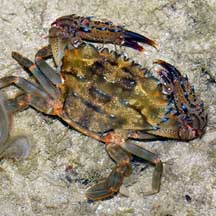
Crabs are among the more familar crustaceans |
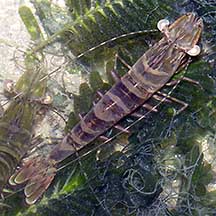
Prawns are crustaceans
too. |
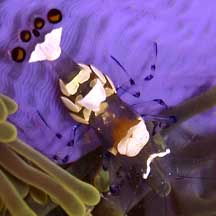
Anemone shrimps live in a sea anemone!
Pulau Hantu, Apr 04 |
Crustaceans come in a wide range of body forms. Some adults are so
unlike 'typical' crustaceans that it is hard to believe they are related
to familiar creatures like shrimps and crabs. These include barnacles,
often mistaken for oysters or limpets, and parasitic
barnacles that invisible for most of their lifecycle! Sea
slaters scurry about by the hundreds over rocks at low tide and
are often mistaken for insects or cockroaches. They are, however,
crustaceans just like crabs and prawns.
One crustacean characteristic that distinguish them from other arthropods
is that at some time in their life cycle, crustaceans have two pairs
of antennae. All other arthropod groups only have one pair. Most crustaceans
have limbs that are branched (biramous), while other arthropods don't.
Classifying Crustacea: Nearly
60% of crustaceans fall into the Class Malacostraca. Most malacostracans
(10,000 species) belong to the Order Decapoda.
from Edward E.
Ruppert, Richard S. Fox, Robert D. Barnes. 2004.Invertebrate
Zoology Brooks/Cole of Thomson Learning Inc., 7th Edition. pp. 963 Brooks/Cole of Thomson Learning Inc., 7th Edition. pp. 963 |
Crusty cast-off: Like other Arthropods, crustaceans have
to shed their hard outer skeleton (exoskeleton) in order to grow bigger.
The process is called moulting and is quite fascinating. More
about moulting.
Human uses: Crustaceans are eaten by people everywhere.
Barnacles grow on any surface in the sea, including ships, water pipes
and other important infrastructure. Thus these tiny animals can affect
human activities in a big way.
Status and threats: Sadly, many
of our beautiful and fascinating crustaceans are listed among the
endangered animals of Singapore. Like other marine creatures, they
are vulnerable to habitat loss due to reclamation or human activities
along the coast that pollute the water. They are also vulnerable to
trampling by careless visitors and over-collection for food and for
their shells can affect local populations. |
Threatened
marine crustaceans of Singapore
From Davison,
G.W. H. and P. K. L. Ng and Ho Hua Chew, 2008. The Singapore Red
Data Book: Threatened plants and animals of Singapore.
True
crabs (Marine)
| |
Gomeza
bicornis (VU: Vulnerable)
Jonas formosae (VU: Vulnerable) |
| |
Doclea
canaliformis (EN: Endangered)
Hyastenus elatus (EN: Endangered)
Hyastenus subinermis (EN: Endangered)
Menaethius monoceros (One-horned spider crab) (VU: Vulnerable) |
| |
Discoplax
hirtipes (NE: Presumably Nationally Extinct) |
| |
Crustaenia
palawanensis (EN: Endangered)
Elamena globosa (EN: Endangered)
Elamena mendosa (EN: Endangered)
Elamenopsis rotunda (CR: Critically endangered)
Halicarcinus coralicola (VU: Vulnerable)
Neorhunchoplax mangalis (VU: Vulnerable) |
| |
Camposcia
retusa (Velcro crab) (VU: Vulnerable)
Paratymolus cygnus (CR: Critically endangered) |
| |
Alox
somphos (EN: Endangered)
Favus granulatus (Rubble crab) (EN: Endangered)
Praosia punctata (EN: Endangered) |
| |
Planotergum
mirabile (EN: Endangered) |
| |
Dotilla sp. (Soldier crabs)
Dotilla myctiroides (VU: Vulnerable)
Ilyoplax
sp. (Semaphore crabs)
Ilyoplax delsmani (VU: Vulnerable)
Ocypode sp. (Ghost crabs)
Ocypode cordimanus
(VU: Vulnerable)
Uca sp. (Fiddler
crabs)
Uca rosea (Rosy fiddler crab) (EN: Endangered) |
| |
Aulacolambrus
granulosus (CR: Critically endangered)
Cryptopodia fornicata
(Domed elbow crab) (EN: Endangered)
Daldorfia horrida (NE: Presumed Nationally Extinct)
Platylambrus echinatus (EN: Endangered)
Pseudolambrus bicornis (Two horned elbow-crab) (CR: Critically
endangered)
Rhinolambrus pelagicus (VU: Vulnerable) |
| |
Glabropilumnus
edamensis (VU: Vulnerable)
Gonatonotus pentagonus (EN: Endangered)
Harrovia albolineata (Feather star crab) (CR: Critically
endangered)
Harrovia longipes (Feather star crab) (CR: Critically
endangered)
Hypocolpus rugosus (CR: Critically endangered)
Metonia lanka (VU: Vulnerable)
Parapanope euagora (EN: Endangered)
Pilumnus murphyi (VU: Vulnerable)
Pilumnus ohshimai (EN: Endangered)
Retelumnus labyrinthicus (VU: Vulnerable)
Rhizopoides yangae (EN: Endangered)
Zebrida adamsi (EN: Endangered) |
| |
Lucocyclus
rotundatus (NE: Presumed Nationally Extinct) |
| |
Geosesarma
nemesis (EN: Endangered)
Geosesarma peraccae (VU: Vulnerable)
Haberma nanum (VU: Vulnerable)
Sarmatium germaini
(Mound crab) (EN: Endangered)
Sesarmoides borneensis (EN: Endangered) |
| |
Atergatis
floridus (Floral egg crab) (VU: Vulnerable)
Atergatis integerrimus
(Red egg crab) (VU: Vulnerable)
Lophozozymus pictor
(Mosaic reef crab) (EN: Endangered)
Banareia subglobosa (EN: Endangered)
Cymo andreossyi (Hairy coral crab) (VU:Vulnerable)
Neoxanthops lineatus (EN: Endangered)
Novactaea bella (EN: Endangered)
Palapedia valentini (VU: Vulnerable)
Platypodia granulosa
(Curry Puff reef crab) (EN: Endangered)
Zalasius horii (Paddington Bear crab) (CR: Critcially
Endangered) |
True crabs (Freshwater)
| |
Johora
singaporensis (EN: Endangered) |
| |
Irmengardia
johnsoni (Johnson's freshwater crab) (EN: Endangered)
Parathelphusa reticulata (Swamp forest crab) (EN: Endangered)
|
Prawns
and shrimps see
list on the group page
Hermit crabs
| |
Coenobita
sp. (Land hermit crab)
Coenobita cavipes (VU: Vulnerable)
Coenobita violascens (VU: Vulnerable) |
| |
Eulenaios
cometes (EN: Endangered)
Porcellanella
picta (Painted porcelain crab) (VU: Vulnerable)
Pseudoporcellanella monoliensis (False porcelain crab)
(VU: Vulnerable)
Raphidopus ciliatus (VU: Vulnerable) |
Lobsters
and lobster-like animals
| |
Thalassina
sp. (Mud
lobsters)
Thalassina anomala (EN: Endangered)
Thalassina gracilis (EN: Endangered) |
| |
Wolffogebia
phukentensis (EN: Endangered) |
|
Links
References
- Jones Diana
S. and Gary J. Morgan, 2002. A Field Guide to Crustaceans of
Australian Waters. Reed New Holland. 224 pp.
- Wee Y.C.
and Peter K. L. Ng. 1994. A First Look at Biodiversity in Singapore.
National Council on the Environment. 163pp.
- Davison,
G.W. H. and P. K. L. Ng and Ho Hua Chew, 2008. The Singapore
Red Data Book: Threatened plants and animals of Singapore.
Nature Society (Singapore). 285 pp.
- Jones Diana
S. and Gary J. Morgan, 2002. A Field Guide to Crustaceans of
Australian Waters. Reed New Holland. 224 pp.
- Debelius,
Helmut, 2001. Crustacea
Guide of the World: Atlantic Ocean, Indian Ocean, Pacific Ocean
IKAN-Unterwasserachiv, Frankfurt. 321 pp.
- Gosliner,
Terrence M., David W. Behrens and Gary C. Williams. 1996. Coral
Reef Animals of the Indo-Pacific: Animal life from Africa to Hawaii
exclusive of the vertebrates
Sea Challengers. 314pp.
|
|
|




